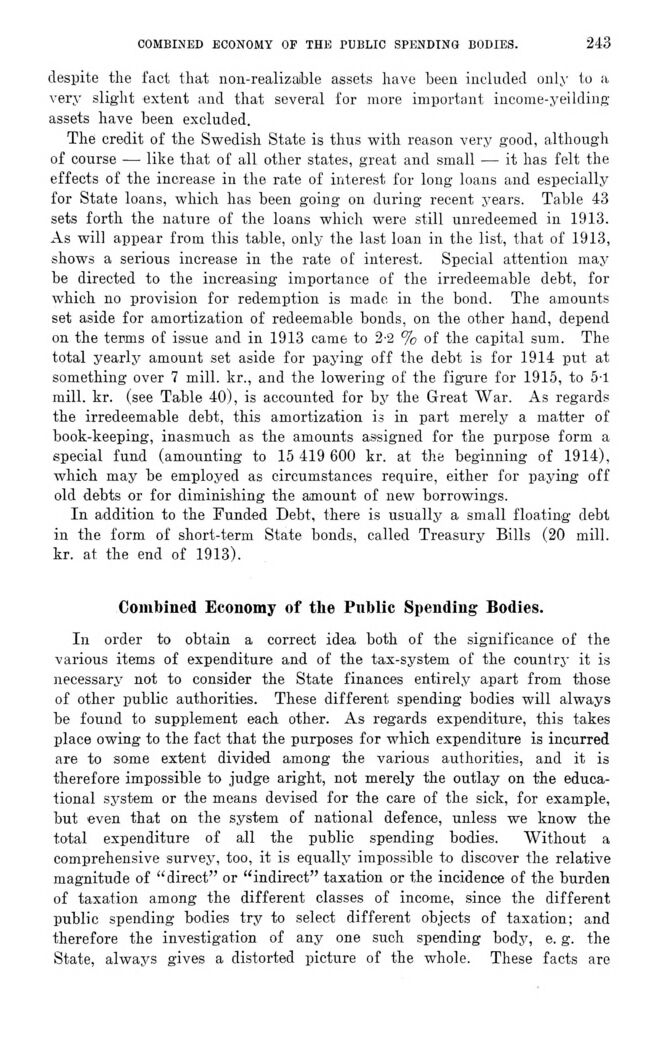
Full resolution (JPEG) - On this page / på denna sida - III. Constitution and Administration. Introd. by E. Hildebrand - 2. State Administration. By E. Söderberg - State Finances. By Eli F. Heckscher - Combined Economy of the Public Spending Bodies. By Eli F. Heckscher

<< prev. page << föreg. sida << >> nästa sida >> next page >>
Below is the raw OCR text
from the above scanned image.
Do you see an error? Proofread the page now!
Här nedan syns maskintolkade texten från faksimilbilden ovan.
Ser du något fel? Korrekturläs sidan nu!
This page has never been proofread. / Denna sida har aldrig korrekturlästs.
combined economy op the public spending bodies.
243
despite the fact that non-realizable assets have been included only to a
very slight extent and that several for more important income-yeikliiig
assets have been excluded.
The credit of the Swedish State is thus with reason very good, although
of course — like that of all other states, great and small — it has felt the
effects of the increase in the rate of interest for long loans and especially
for State loans, which has been going on during recent years. Table 43
sets forth the nature of the loans which were still unredeemed in 1913.
As will appear from this table, only the last loan in the list, that of 1913,
shows a serious increase in the rate of interest. Special attention may
be directed to the increasing importance of the irredeemable debt, for
which no provision for redemption is made in the bond. The amounts
set aside for amortization of redeemable bonds, on the other hand, depend
on the terms of issue and in 1913 came to 2-2 % of the capital sum. The
total yearly amount set aside for paying off the debt is for 1914 put at
something over 7 mill, kr., and the lowering of the figure for 1915, to 5-1
mill. kr. (see Table 40), is accounted for by the Great War. As regards
the irredeemable debt, this amortization is in part merely a matter of
book-keeping, inasmuch as the amounts assigned for the purpose form a
special fund (amounting to 15 419 600 kr. at the beginning of 1914),
which may be employed as circumstances require, either for paying off
old debts or for diminishing the amount of new borrowings.
In addition to the Funded Debt, there is usually a small floating debt
in the form of short-term State bonds, called Treasury Bills (20 mill,
kr. at the end of 1913).
Combined Economy of the Public Spending Bodies.
In order to obtain a correct idea both of the significance of the
various items of expenditure and of the tax-system of the country it is
necessary not to consider the State finances entirely apart from those
of other public authorities. These different spending bodies will always
be found to supplement each other. As regards expenditure, this takes
place owing to the fact that the purposes for which expenditure is incurred
are to some extent divided among the various authorities, and it is
therefore impossible to judge aright, not merely the outlay on the
educational sj^stem or the means devised for the care of the sick, for example,
but even that on the system of national defence, unless we know the
total expenditure of all the public spending bodies. Without a
comprehensive survey, too, it is equally impossible to discover the relative
magnitude of "direct" or "indirect" taxation or the incidence of the burden
of taxation among the different classes of income, since the different
public spending bodies try to select different objects of taxation; and
therefore the investigation of any one such spending body, e. g. the
State, always gives a distorted picture of the whole. These facts are
<< prev. page << föreg. sida << >> nästa sida >> next page >>